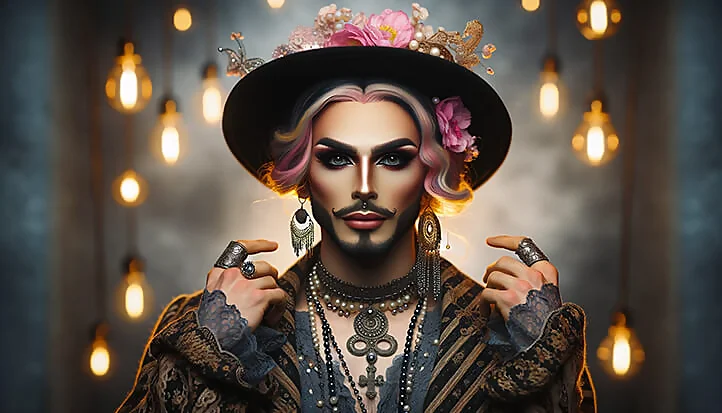Transgenderism is a condition in which a person’s gender identity does not correspond to the biological sex assigned to them at birth. Transgender people may identify as men, women, or opt out of traditional gender categories, seeking a life that better reflects their internal sense of self.
In simple terms, if a person is born male but feels and identifies as female (or vice versa), they can be considered transgender. If they choose, they may alter their appearance, name, and even undergo gender reassignment surgery to make their outward appearance match their inner perception of themselves.
In modern society, the issue of transgenderism is becoming increasingly visible and widely discussed, reflecting a broad spectrum of views and approaches. On the one hand, awareness and support for transgender people are growing, including the recognition of their rights and the pursuit of inclusivity in various spheres of life—from social integration to medical and legal aspects. Initiatives to protect transgender rights, such as anti-discrimination legislation and the ability to amend identity documents, are becoming more widespread in many countries.
On the other hand, transgender people still face significant challenges, including discrimination, transphobia, and a lack of access to quality healthcare. In some regions and societies, conservative views persist, causing transgender people to experience social isolation and stigmatization.
Thus, the modern view of transgenderism is characterized by a dynamic balance between advancing rights and openness on the one hand, and remaining obstacles and challenges on the other. The process of finding paths to mutual understanding, equality, and respect for the diversity of gender identities continues.

History of Transgenderism
The history of transgenderism spans from ancient times to the present day, reflecting various cultural, social, and historical contexts in which gender norms and identities have been shaped and transformed.
- In ancient civilizations, many cultures recognized the existence of more than two genders and respected people whose gender identity differed from traditional male or female roles. For example, in the cultures of Native American tribes such as the Navajo and Zuni, people with ambiguous gender status, sometimes referred to as “two-spirit,” were respected.
- In the Middle Ages and the modern era in Europe and other regions, under the influence of the Christian church and other religious and social institutions, approaches to gender became stricter, and people who did not conform to traditional gender norms often faced persecution and discrimination.
- In the 19th century, the scientific study of gender and sexuality began, including early attempts to medically and psychologically explain transgenderism. This time also marks the beginning of the formation of concepts and terminology related to transgender studies.
- The 20th century became a period of activism for transgender rights, especially in the second half of the century when LGBT+ rights movements gained significant momentum. Key milestones included the creation of the first transgender organizations, the development of medical procedures for gender reassignment, and the emergence of prominent public figures from the transgender community.
- The 21st century is characterized by an intensified struggle for transgender people’s rights, increased access to healthcare, and legal protections. The internet and social media are vital tools for raising awareness about transgender people and forming support communities and solidarity.
Despite significant progress, transgender people still face discrimination, misunderstanding, and violence in many parts of the world. The history of transgenderism is a history of the struggle for recognition, equality, and the right to self-identification, which continues to this day.
Key Moments in the History of the Transgender Movement
The history of the transgender movement includes many significant events and moments that contributed to the development and recognition of transgender people and their rights. Below are some of these important moments:
- 1952 – Christine Jorgensen becomes one of the first Americans to gain widespread fame after undergoing gender reassignment surgery, drawing attention to transgender issues.
- 1966 – The “Compton’s Cafeteria Riot” in San Francisco, one of the first known transgender uprisings against police violence.
- 1969 – The Stonewall Inn riot in New York City is often considered the beginning of the modern LGBT rights movement, in which transgender people actively participated.
- 1970s – The formation of the first support groups and organizations aimed at protecting transgender rights, such as the “Transgender Alliance” and the “International Foundation for Gender Education.”
- 1980 – The inclusion of the term “transsexuality” in the Diagnostic and Statistical Manual of Mental Disorders (DSM), sparking numerous debates and criticism.
- 1999 – The publication of the “Transgender Bill of Rights,” a declaration aimed at protecting and recognizing transgender rights.
- 2000s – An increase in the representation of transgender people in media and popular culture, as well as legislative recognition and protection of their rights in some countries.
- 2015 – Bruce Jenner (decathlete, record holder, and Olympic Games medalist) publicly announces a transition to using the pronoun “she” and becomes Caitlyn Jenner, one of the most famous transgender personalities, sparking significant public discussion on the topic of transgenderism.
- 2020s – The continued struggle for transgender people’s rights, including access to healthcare, protection from discrimination, and the recognition of their rights in various aspects of public life.

What Influences the Emergence of Transgenderism?
Scientific explanations of the emergence of transgenderism span multiple disciplines, including genetics, endocrinology, neuroscience, and psychology. While the exact cause of transgenderism has not been fully determined, research suggests several key factors that may contribute to the development of transgender identity:
Biological Factors
- Genetics. Some studies suggest a possible genetic influence on transgenderism, indicating that certain genetic variations may be linked to gender identity.
- Hormonal Influences. The level and balance of sex hormones during critical periods of fetal development may affect the formation of gender identity. Abnormalities in exposure to sex hormones can impact gender development in the brain.
- Neurobiology. Some studies show differences in brain structure and function between transgender and cisgender individuals that correspond to their gender identity rather than the sex assigned at birth. This indicates that neurobiological features may play a role in the development of transgenderism.
Psychological and Social Factors
While most studies emphasize the biological foundations of transgenderism, psychological and social aspects are also important for understanding gender identity. Upbringing, social interactions, and cultural norms can influence personal awareness and expression of gender identity, though they do not “cause” transgenderism.
It is important to understand that transgenderism is not a person’s “choice” or a mental disorder. It is an aspect of gender identity that results from a complex interplay of genetic, biological, psychological, and social factors. The scientific community continues to explore these complex interactions to better understand the foundations of gender identity and support the well-being of transgender people.
Thus, although the exact mechanisms underlying transgenderism are not fully understood, there is a general consensus that a combination of biological and possibly psychosocial factors plays a role in the development of a person’s gender identity.

The Difference Between Transgender and Transsexual
Transgender and transsexual are terms often used in discussions about gender identity, but they refer to different concepts.
- Transgender describes a broad spectrum of gender identities and expressions that do not align with traditional ideas of how people should look or behave based on the biological sex assigned at birth. Transgender individuals may identify as men, women, both, neither, or somewhere unique on the gender spectrum. For many transgender people, gender identity is not directly related to a desire to undergo medical procedures for gender transition.
- Transsexual is a more specific term generally used to describe people who not only identify with a gender different from their birth-assigned one but also seek or undergo medical procedures (such as hormone therapy or sex reassignment surgery) to align their physical body with their gender identity. Thus, the term “transsexual” is often associated with a specific desire and process of physical transition from one sex to another.
It is important to note that in contemporary society, terminology and understanding of gender identity continue to evolve. Many people and communities prefer the term “transgender” due to its broadness, emphasizing that gender identity is not solely a matter of the physical body but also a deeply personal experience of self and one’s place in the world of genders.

The Gender Identity Spectrum
The gender identity spectrum describes the wide range of genders that people may experience and express, moving beyond the traditional binary understanding of gender as exclusively male or female. This spectrum acknowledges that gender identity is an internal, personal sense of one’s gender, which may or may not correspond to the biological sex assigned at birth.
Key aspects of the gender identity spectrum include:
- Transgender: Individuals whose gender identity does not align with the sex assigned at birth.
- Cisgender: People whose gender identity aligns with the sex assigned at birth.
- Non-binary or genderqueer: Individuals who do not identify exclusively as male or female. They may blend aspects of both genders, have no gender at all, or occupy a unique position on the gender spectrum.
- Genderfluid: People whose gender identity can change over time.
- Agender: Those who do not experience any internal sense of gender.
- Bigender: Individuals who identify with two genders simultaneously or switch between them.
Understanding the gender identity spectrum highlights that gender is a complex and diverse phenomenon, which cannot be confined to simple binary classifications. Respecting and acknowledging this diversity is crucial to supporting the well-being and equality of all people, regardless of their internal gender perception.

Gender Dysphoria
Gender dysphoria describes the deep sense of incongruence or discomfort that a person may feel due to the difference between their internal gender identity and biological sex. This condition involves not just superficial dissatisfaction with appearance or societal roles but profound psychological pain and distress caused by the mismatch between self-perception and societal expectations.
Gender dysphoria can be accompanied by a range of emotional and psychological challenges, such as anxiety, depression, feelings of isolation and misunderstanding, and issues with self-esteem and self-identification. People experiencing gender dysphoria may face difficulties in social interactions, professional activities, and personal relationships, which can exacerbate their psychological state.
Psychological support for individuals with gender dysphoria includes counseling with psychologist to help them better understand their gender identity and develop coping strategies to reduce stress.
A key part of this support is the affirmative approach, which upholds the person’s right to gender self-determination and may include medical interventions such as hormone therapy or sex reassignment surgery for those who choose this path.
Recognizing and acknowledging gender dysphoria as a serious psychological condition is essential to providing adequate support and respect for the rights and well-being of transgender people, promoting a more inclusive and understanding society.

Gender Transition Process
The gender transition process for transgender individuals involves a series of medical and social steps designed to help a person live in alignment with their internal gender identity. This process is deeply individual and may involve different aspects depending on personal goals, needs, and circumstances.
Medical Aspects
- Hormone Therapy: The use of hormones to change secondary sexual characteristics, such as hair growth, voice, fat distribution, and muscle mass, to better align with the person’s gender identity.
- Sex Reassignment Surgery: This includes a wide range of surgical procedures, such as mastectomy (removal of breasts), phalloplasty or vaginoplasty, breast augmentation, and other procedures aimed at changing the body to match gender identity.
- Psychological Counseling and Psychotherapy: Providing help in developing coping strategies, supporting decision-making, and addressing the emotional and psychological aspects of the gender transition.
Social Aspects
- Name and/or Gender Change in Documents: Officially changing one’s name and gender marker on identification documents, passports, driver’s licenses, and other official records.
- Coming Out: Informing friends, family, colleagues, and other significant people about one’s gender identity. This can be a challenging and emotional process, requiring considerable preparation and support.
- Adapting to a New Social Role: Involves changing one’s appearance through clothing, hairstyle, and behavior, as well as adjusting to new social roles and expectations.
The gender transition process has a profound impact on the well-being and quality of life of transgender individuals, providing them with the opportunity to live in greater harmony with their identity. However, this path may be accompanied by stigma, discrimination, and various barriers to accessing medical care and social support. Therefore, understanding from society, medical professionals, and social services is critically important for improving the overall well-being of transgender people.

Legal Issues and the Protection of Transgender Rights
Legal issues and the protection of transgender people’s rights are crucial aspects of ensuring their equality and dignity in society. Legal protections address several key areas, including but not limited to:
- Registration of Gender and Document Changes. One of the main legal challenges for transgender people is the process of officially recognizing their gender identity, which includes changing their name and gender on official documents, such as IDs, passports, driver’s licenses, and birth certificates. Different jurisdictions have different requirements and procedures for making these changes.
- Protection from Discrimination. Legislation aimed at protecting transgender people from discrimination in employment, education, healthcare, housing, and public services is essential to ensuring their equality. In some countries, anti-discrimination laws explicitly include protection based on gender identity.
- Access to Healthcare. Access to quality healthcare, including hormone therapy and gender-affirming surgeries, is critically important for many transgender individuals. Legal protections in this area aim to fight discrimination by healthcare providers and insurance companies.
- Equality in Education. Ensuring a safe and supportive educational environment for transgender students, including access to appropriate restrooms and locker rooms, as well as respect for their gender identity by teachers and peers, is a key legal issue.
- Protection from Violence and Hate Crimes. Transgender people often face the threat of physical violence and hate crimes. Establishing and enforcing laws that protect against such crimes and provide legal remedies for victims is critical to their safety.
All of these areas require a comprehensive approach and collaboration between human rights organizations, governments, and international bodies to create a more inclusive and just society where transgender people’s rights are protected and respected.

Public Perception of Transgender Identity
Changes in public perception of transgender identity over recent years reflect a significant shift toward greater recognition and understanding of gender diversity. These changes occur at various levels, from cultural norms and media representation to legislation and social practices.
- Cultural Shift. Cultural views on transgender identity have evolved, partly due to the increased inclusion of transgender stories and characters in films, TV shows, literature, and other aspects of popular culture. This has raised awareness and contributed to better understanding of transgender people.
- Media Representation. Media plays a key role in shaping public views. The growing visibility of transgender people in the news, on television, and in social media helps shift the narrative, making it more inclusive and diverse.
- Legislative Changes. Around the world, new laws are being passed, and existing ones amended, to ensure equal rights and protection for transgender individuals. This includes laws that prohibit discrimination based on gender identity and simplify the process of changing gender markers on official documents.
- Education and Awareness. Efforts to raise awareness and educational programs aimed at explaining gender diversity contribute to the changing perception of transgender identity. Schools, universities, and various educational platforms are implementing curricula that include information on gender identity.
- Social Support and Acceptance. Growing recognition and support from the public, including the formation of support communities and the organization of public events like Pride parades, help create a more open and accepting society for transgender people.
These shifts in public perception of transgender identity result from years of activism, organizational efforts, and supportive communities fighting for equality, justice, and respect for gender diversity. Despite the progress, ongoing debates and challenges indicate that much work remains to achieve full recognition and inclusivity.
The Role of Media and Popular Culture in Shaping the Image of Transgender People
Media and popular culture play a crucial role in shaping public perceptions of transgender people. Their influence covers a broad range of important points, from breaking stereotypes to creating greater visibility and understanding of gender diversity. Here are some key ways in which media and popular culture influence the image of transgender people:
- Breaking Stereotypes. Depicting transgender people in more complex and diverse lights (films, TV shows, and literature) helps break down longstanding stereotypes. By portraying transgender people as fully realized characters with deep personal stories, media contributes to better understanding and empathy from the wider audience.
- Increasing Visibility. The inclusion of transgender characters and real-life figures in popular media increases their visibility in society. This gives people the opportunity to learn about the lives of transgender people, their challenges, and their successes, which is crucial for fostering understanding and respect for diverse gender identities.
- Educating the Audience. Media and popular culture often serve as primary sources of information about transgender identity for many people. Through documentaries, educational programs, and news articles, audiences gain knowledge about gender identity, issues of discrimination, and the importance of gender equality.
- Promoting Social Acceptance. Positive and accurate representation of transgender people in the media and popular culture fosters social acceptance and support. When transgender characters and individuals are portrayed with respect and dignity, it helps shape a more inclusive society.
- Influencing Public Opinion and Policy. Public discussions and debates generated by media and popular culture influence public opinion and even political decisions regarding transgender rights. High awareness and public support can encourage the adoption of laws and policies aimed at protecting transgender people’s rights and well-being.
It is essential for media and popular culture creators to strive for responsible and respectful representation of transgender people so that their contribution to shaping public perceptions is positive and fosters the development of a more just and equitable society.
Key Challenges Facing Transgender People
Transgender individuals face many challenges in various aspects of life, many of which are related to discrimination, misunderstanding, and stigmatization of their gender identity. Here are some of the key challenges:
- Discrimination and Stigmatization. One of the most significant issues is widespread discrimination and stigmatization of transgender people in society. This can occur in educational and healthcare institutions, in the workplace, and in everyday social interactions.
- Access to Healthcare. Transgender individuals often face barriers to accessing quality healthcare, including hormone therapy and gender-affirming surgeries. A lack of doctors specializing in transgender healthcare, as well as discrimination from medical staff, are serious concerns.
- Legal and Administrative Barriers. Many transgender people encounter difficulties when trying to change their name and gender in official documents, which often leads to various legal and administrative problems in daily life, including challenges with employment, education, and travel.
- Social Isolation and Mental Health. Due to stigmatization and discrimination, transgender people often face social isolation, which can lead to deteriorating mental health, including depression, anxiety, and a higher risk of suicide.
- Violence and Hate Crimes. Transgender people are at a higher risk of being victims of violence and hate crimes compared to the cisgender population. This includes physical assaults, sexual violence, and even murders.
- Employment Issues. Discrimination in the workplace and in hiring is a common problem for many transgender people, leading to unemployment or being forced to work in conditions that do not match their qualifications or interests.
- Educational Barriers. Transgender students may face discrimination and misunderstanding in educational settings, which affects their academic performance and overall well-being.
Addressing these challenges requires a comprehensive approach, including legislative changes, educational programs to raise awareness, and support from society and human rights organizations.
The Importance of Support Groups
Support groups play an important role in the lives of transgender people by providing an environment where they can feel understood, accepted, and supported. These communities serve several key functions that contribute to the well-being and development of transgender individuals:
- Emotional and Psychological Support. Transgender people often face discrimination, misunderstanding, and isolation in society. Support groups provide a safe space for discussing personal experiences, fears, and challenges. Sharing experiences and advice helps participants cope with problems and feel less alone.
- Educational Resources. Many support groups and communities offer educational resources and information sessions on important aspects of transgender identity, including medical and legal issues, as well as ways to combat discrimination. This helps transgender people make informed decisions about their health and well-being.
- Social Support Networks. Building a social support network is one of the most significant functions of these groups. The opportunity to meet and connect with people going through similar life stages significantly reduces feelings of isolation and loneliness. Friendships and camaraderie in such groups have a huge positive impact on self-esteem and overall well-being.
- Advocacy and Rights Protection. Many support groups and communities are involved in advocacy and the protection of transgender people’s rights, working to expand their rights and freedoms. They may organize events, fundraising campaigns, educational programs for the general public, and participate in the political process to raise awareness of transgender issues and fight for equality.
- Resources and Service Referrals. Support groups often provide information about medical, psychological, and legal services available to transgender people. This may include lists of trans-friendly doctors, lawyers, psychologists, and other specialists, as well as information about assistance and support programs.

Conclusion
Understanding and recognizing transgender identity in society is a fundamental aspect of creating a tolerant world where everyone can live openly without fear of discrimination or violence. When society acknowledges and understands transgender identity, it helps break down stereotypes and reduces the pressures faced by transgender individuals in everyday life. This not only improves their psychological well-being and overall health but also promotes equality in education, employment, and access to quality healthcare.
Awareness plays a key role in forming a supportive society. Including information about gender diversity in educational programs fosters a generation more accepting of differences and competent in gender issues. This contributes to social progress, emphasizing the importance of personal autonomy and respect for human dignity.
Recognition of transgender identity also influences the development of legislation that ensures the protection of transgender rights, including the right to change identity documents and access appropriate medical care without discrimination. Such legislation reflects society’s acknowledgment of every individual’s right to self-determination and respect for their gender identity, which is the foundation of justice and equality.
Ultimately, a society that understands and recognizes transgender identity promotes the full integration of transgender individuals into social life, where respect for diversity and support for each person are key values.

List of Resources and Further Reading
Here is a list of helpful online resources with essential information for transgender people, their loved ones, and those interested in the topic:
- Insight – a Ukrainian public organization that offers comprehensive support for transgender individuals, including psychological, legal, and medical assistance.
- National Center for Transgender Equality (NCTE) – the National Center for Transgender Equality in the United States offers a wealth of informational materials.
- Transgender Europe (TGEU) – a network working on issues of transgender rights and well-being in Europe and Central Asia. They conduct research, campaigns, and educational projects to raise awareness of transgender rights and issues.
- Mermaids UK – a British charity supporting transgender children, teenagers, and their families. Mermaids provides help and advice, including a helpline, educational workshops, and legal support.
Here is a list of books on transgender identity, which serve as excellent starting points for a deeper understanding of this topic:
- “Whipping Girl: A Transsexual Woman on Sexism and the Scapegoating of Femininity” – by Julia Serano. This book is part seminar, part autobiography, where the author discusses the impact of gender sexism and stereotypes on transgender women and how they are perceived in society.
- “Transgender History” – by Susan Stryker. This book explores the history of the transgender movement in the United States from the mid-20th century to the present day. Stryker provides context and analysis to understand the social, political, and cultural changes that have shaped the transgender community and its fight for rights.
- “Gender Outlaw: On Men, Women, and the Rest of Us” – by Kate Bornstein. This book is both a memoir and a critical reflection on gender beyond traditional binary concepts. Bornstein shares her experience of transitioning from male to female and discusses how concepts of masculinity and femininity limit individual freedom.
- “The Transgender Child: A Handbook for Families and Professionals” – by Stephanie A. Brill and Rachel Pepper. This practical guide is designed for families and professionals working with transgender children. It provides information about gender variance in children, advice on parenting and care, and recommendations for creating a supportive environment.
- “Redefining Realness: My Path to Womanhood, Identity, Love & So Much More” – by Janet Mock. In this autobiography, Mock shares her journey toward self-recognition as a transgender woman, discussing themes of identity, love, and life. She shares stories from her childhood, adolescence, and adulthood, highlighting the challenges transgender people face.




